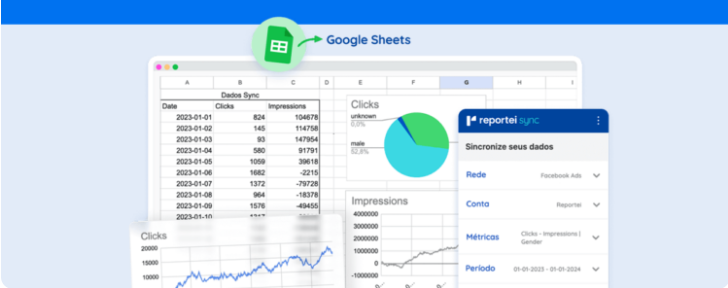Understand why the annual marketing report is crucial for your strategy and check out tips to develop yours more efficiently
In the digital marketing universe, where strategies evolve as quickly as trends, the ability to evaluate and learn from past experiences is essential. It’s in this context that the annual report stands out as a fundamental tool to guide future decisions, refine actions, and, of course, celebrate the project’s achievements.
Therefore, in this article, we’ll explore 5 steps to simplify the analysis of annual data, turning relevant information into actionable insights. Follow along!
Why Create an Annual Marketing Report?
Creating an annual marketing report is a vital practice for companies looking to assess, improve, and optimize their strategies over time. Here are the main reasons to invest time and resources in preparing this document:
- Performance Evaluation: The annual report offers a valuable opportunity to assess the performance of marketing campaigns and initiatives throughout the year. Thus, analyzing key metrics – such as conversion rates, return on investment (ROI), and engagement metrics – allows identification of what worked well and what needs adjustment.
- Informed Decision-Making: Based on data analysis, marketers can make more informed decisions. Identifying trends helps direct resources to the most effective strategies, avoiding unnecessary investments in approaches that did not yield desired results.
- Continuous Improvement: By understanding opportunity areas and challenges faced during the year, marketing teams can develop action plans to overcome obstacles and continuously optimize their initiatives.
- Accountability: The annual report serves as an accountability mechanism for marketing teams. By setting goals and measuring performance against these objectives, teams can demonstrate their value to clients or decision-makers.
- Strategic Alignment: It allows reviewing if marketing activities align with the company’s overall goals. This ensures that marketing strategies contribute to the organization’s success.
- Internal and External Communication: A well-crafted report is a powerful communication tool. Internally, it helps align different departments and teams around marketing goals. Externally, it can be used to showcase achievements to clients, investors, and other stakeholders.
- Planning for the Future: By analyzing past performance, the report aids in formulating strategies for the future. This includes identifying new opportunities, adjusting approaches, and setting ambitious yet achievable goals for the next year.
In summary, creating an annual marketing report is not just an administrative task but a strategic practice that greatly contributes to a company’s growth and success.
5 Steps to Create an Annual Marketing Report
Check out our tips below to develop more efficient annual reports, from defining objectives to planning future actions.
Keep in Mind the Objectives and Goals of the Project
A foundation in creating an annual marketing report is alignment with the objectives and goals set for the project. Even before diving into data and analysis, it’s essential to ask: what do we want to communicate to the client? What are the main success indicators we aim to achieve?
From the initial data collection to the final presentation, keeping the objectives in mind not only ensures coherence in the report but also provides a solid basis for precise analyses and strategic recommendations.
It guarantees that, at the end of the process, not just numbers are reported, but the story of how the team achieved these results.
Define the Key Metrics
A crucial step in creating an annual marketing report is defining the metrics to be tracked. With so much data available, it’s easy to get lost in numbers that, although interesting, may not be essential to assessing the success of applied strategies.
In this process, the focus is on indicators directly related to the business objectives. Therefore, metrics can range from conversion rates and cost per lead to social media engagement and return on investment (ROI).
The important thing is that the choice is clearly connected to the desired results, turning the data into an efficient guide for evaluating overall performance.
Compare with the Previous Year
A vital aspect of preparing an annual marketing report is comparative analysis with the previous year. Comparing key metrics – like traffic growth, conversion rate, and user engagement – provides a comprehensive view of changes over time.
After all, identifying upward or downward trends, past successes, and overcome challenges creates a context for assessing progress and the effectiveness of implemented strategies.
Lastly, comparing with the previous year helps contextualize external events that may have influenced performance, be it market changes, technological advancements, or even economic crises.
Check out the following example of a report from Reportei that compares the results of one year with another in a visual and easy-to-understand manner:

Highlight the Main Campaigns and Events of the Year
By emphasizing the most important campaigns, achievements, and notable events, the annual report not only celebrates success but also provides deeper insight into what drove positive performance.
This section is not just a reflection of the past but an opportunity to retell the story in an engaging way. Use visual data, testimonials, and tangible results to illustrate the impact of the campaigns, offering clients a richer understanding of the role each initiative played in the project.
Present a Plan for the Next Year
Beyond shedding light on the accomplishments and challenges of the past year, the annual marketing report is a strategic guide for the future. Therefore, it should also include a plan for the next year, with suggestions to help the company develop online.
By outlining a solid plan, you can highlight the lessons learned, identified opportunities, and strategies that proved most effective. These are not just generic ideas but recommendations based on concrete data and detailed analyses.
With this planning, you not only anticipate potential challenges but also identify innovations and growth opportunities. In doing so, the report evolves from a retrospective document into a proactive tool for future success.
Learn How to Record All the Year’s Events with Reportei
With Reportei, in addition to creating strategic monthly and annual reports – with all records of your actions –, you also have the opportunity to use the Timeline feature to develop a complete history of the project.

This feature is available in all accounts and allows for the creation of milestones in chronological order. That is, decision-makers can closely follow the campaigns launched, meetings held, changes in strategies, and much more.
Therefore, when creating the annual marketing report to present to clients, you can merge the metrics with the Timeline records, which helps to develop storytelling based on data.
Take advantage of Reportei’s metric automation features and timeline creation to generate much more accurate and efficient annual, monthly, and biweekly reports!



